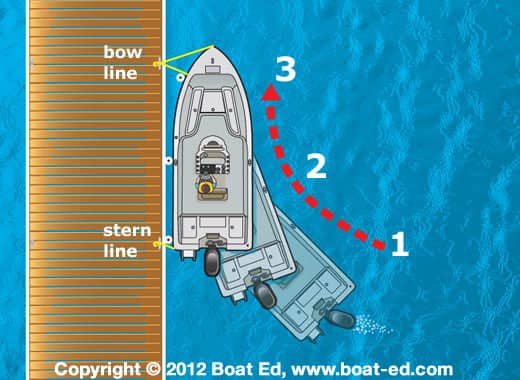How To Dock Your Boat Safely
Boat-ed 03.12.12

Part of knowing how to operate your boat safely is knowing how to dock it. The following docking procedures are for small, single-engine boats. Docking procedures will vary for large boats, sailboats, or boats with twin engines.
Before docking:
- Reduce your speed to the minimum needed to still be able to steer. Use reverse gear to bring your boat to a stop well away from the dock.
- Determine the wind and/or current direction while stopped by observing which way your boat drifts. If possible, make your approach into the wind or current, whichever is stronger. This will give you more control.
- Have the bow and stern lines ready, and put the boat fenders in place. Fenders are the cushioning devices that you place between boats or between a boat and a dock to prevent damage. You should never plan to stop a moving boat with your arms or legs.
- When the area is clear of traffic, continue your approach.
If there is no wind or current:
- Approach the dock slowly at a narrow angle (about 20 degrees).
- When you’re close enough, have a passenger step on shore and secure the bow line.
- Swing the stern in with a line or boat hook, and secure it.
If the wind or current direction is toward the dock:
- Approach slowly, parallel to the dock.
- Let the wind or current carry your boat to the dock. Shift into gear briefly if you need to adjust position.
- Secure the bow and stern lines.
If the wind or current direction is away from the dock:
- Approach the dock slowly at a sharp angle (about 40 degrees).
- Use reverse to stop when you’re close to the dock. Secure the bow line.
- Put the boat in forward gear briefly, and slowly turn the steering wheel hard away from the dock—this will swing in the stern. Secure the stern line.
Watch the video below to learn how to dock a boat.
httpv://youtu.be/i1iSMWzRuqc
You can learn more about boating safety by taking an online boater safety course. The training offered at this site is approved by the state agencies responsible for boating safety education, and it’s the same material that’s taught in the classroom.
Studying at boat-ed.com is free. Those who must be certified before they can buy a boating license pay a one-time fee, which is due only if they pass the test. Students can take the test as many times as they need to pass it. Online boater safety courses are available in participating states, so visit www.boat-ed.com to take a course specific to your state.




